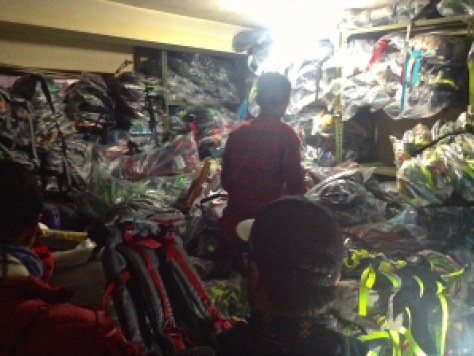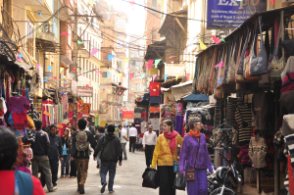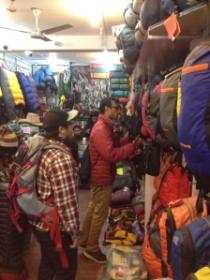KATHMANDU, NEPAL
Most people who visit Nepal will tell stories of the snow capped Himilayas or the preserved old cities of Kathmandu. They may even detail the chaotic traffic or the alarming number of face masks found on pedestrians. But most will forget to mention the 90% off sale found year round in Nepal.
Travelers in developing countries often enjoy a discounted cost of living and lowered prices, but rarely do the deals get better than Nepal. The most impressive prices are on outdoor trekking gear. Patagonia jackets sell for as low as $15, while North Face backpacks sell for a mere $20. And this gear can be seen everywhere in the city. Not just on the backs of tourists. Every taxi driver, shop owner and fruit vendor has a personal winter jacket from a brand name company.
But how?
The secret of the constant sale in Kathmandu comes from the source and quality of products. Nepal is sandwiched between the worlds two most populous countries on earth, India and China. These also happen to be two of the largest consumers and producers of goods.
From conversations with shop vendors, I learned most get their products from China. Some mumbled that they have sources in Nepal, but could not back this up with more specifics. The vendors who had a hook up in China were not much more clear; many said they receive bulk shipments from ‘factories’ in southern China.
Assuming this, the cost of transportation to Nepal is likely lower than to the US. The low cost is aided by transportation on trucks and passing Nepali customs, which are notoriously more relaxed than other inter nation checkpoints.
Nepali backpack salesmen also said they buy in bulk. Some vendors were kind enough to show us their store house of the backpacks and jackets. In one instance, a two vendors shared a dimly lit room full of backpacks piled from floor to ceiling. A sea of backpacks filled the center of the room up to my waist with a small pathway cut through it for access. We spent over thirty minutes searching for the right size and style of backpack, wading through the unwanted ones.

Buying a large quantity at low prices helps explain the low sales price. But, as our tour of the backpack inventory was ending we asked the vendor if he paid for sea of backpacks up front. There were over 1000 backpacks in that store room, all from North Face, Mamut and the other big name outdoor producers. He mumbled something in Nepali. Basically he said he neither paid for all the backpacks up front, but also did not buy them on credit.

This got us thinking that maybe there was a larger supplier between China and the Nepali store fronts. Our imagination conjured up images of a big time backpack dealer; a kingpin with different store fronts. For a moment we thought this was the answer because every store front had the same asking price of 2,500 rupees ($25) and could consistently be bargained down to 1,700-1,800 rupees ($17-18).
The best explanation came from our program coordinator Santosh, who described it as a collective. A number of backpack stores will work with a single importer. That middle man will take the goods from China across the Himilayas to Kathmandu, where he might distribute the truck of goods between many different stores. Those that cannot pay for all the backpacks buy some on credit.

Toward the end of our stay in Kathmandu we wandered into the official North Face store and checked the prices. $200+ for the bigger backpacks. $150 for the smaller ones. The fabric and quality of the zippers differentiated them from the local products.
Returning to some of the local backpack shops, small defects were noticeable- A label was peeling off of one, a zipper was sticky on another. On some jackets the down was synthetic and the ‘Patagonia’ logos on some were clearly not from Patagonia. It became apparent that a portion of the local goods were knock offs.
Not all vendors were cheating their customers however, many of the local goods were simply cheaper because the cost to obtain them was cheaper. Some of the cheap backpacks were labelled as overstocked items from the company factories or just cost less to transport.
For those scammed by the eye-popping prices of Kathmandu consolation comes in the form of functionality. If a jacket keeps you warm and a backpack holds your gear, does it matter if its off brand? Whatever the secret, the deals in Kathmandu are hard to beat.
Cover photo by Jonah M. Kessel
 Rourke Healey is a senior Diplomacy and World Affairs major at Occidental College. He recently returned from conducting research on middle class consumerism in Dar es Salaam, Tanzania. He has also recently completed work with a microfinance group in Kathmandu, Nepal and visited Tangalle, Sri Lanka to cover presidential election.
Rourke Healey is a senior Diplomacy and World Affairs major at Occidental College. He recently returned from conducting research on middle class consumerism in Dar es Salaam, Tanzania. He has also recently completed work with a microfinance group in Kathmandu, Nepal and visited Tangalle, Sri Lanka to cover presidential election.






































 The captain of the ship told us to take refuge down stairs, “because this ones coming fast and strong.” The boat made a sharp turn to the closest point of land and the men on deck tied us to trees so we wouldn’t be blown back down river. We secured hammocks and waited; dosing off to the soothing sound of rain as it started to pour down onto the metal roof and watching as lightning flashed in every direction.
The captain of the ship told us to take refuge down stairs, “because this ones coming fast and strong.” The boat made a sharp turn to the closest point of land and the men on deck tied us to trees so we wouldn’t be blown back down river. We secured hammocks and waited; dosing off to the soothing sound of rain as it started to pour down onto the metal roof and watching as lightning flashed in every direction. We ‘awoke’ to a far emptier, lighter and faster ship and by late morning we arrived at our final destination of Vallemi. After 51 hours on board we said our goodbyes to the crew and stumbled onto shore, relieved to have finally made it and in desperate need of a shower. The owner of the hotel we stayed in asked us where we were coming from and how we got here. We told her we took the Dalma three days up the river. She turned around and looked at our greasy, exhaust covered faces and laughed.
We ‘awoke’ to a far emptier, lighter and faster ship and by late morning we arrived at our final destination of Vallemi. After 51 hours on board we said our goodbyes to the crew and stumbled onto shore, relieved to have finally made it and in desperate need of a shower. The owner of the hotel we stayed in asked us where we were coming from and how we got here. We told her we took the Dalma three days up the river. She turned around and looked at our greasy, exhaust covered faces and laughed.